





Black Widows are one of the most commonly encountered spiders in the garden. Though very poisonous, they are also considered beneficial creatures. The following article serves an introduction to this infamous creature along with some of my personal experiences with Black Widows.
My earliest encounter with these scary garden creatures was at my childhood home in northern New Mexico; my parents had the outdoor furnace entrance in our home cleaned out. A 10-foot deep and 12-foot wide concrete pit, into which a rickety ladder plunged, was almost completely filled with a dense mass of white, irregular, ugly stiff webs, with so many half-inch white spheres dotting them that it looked like it had just been hailing into the pit. It turned out those white spheres were Black Widow Spider egg masses. My father told me later that well over 100 Black Widow spiders were in that gigantic maze of nests and I think I have had well over a dozen nightmares about that spider-filled concrete pit ever since.
For some reason nearly every place I have lived has been heavily populated with Black Widows. I must have seen thousands of these creatures over the years and I sometimes marvel that I have not only survived the experiences, but have not even once been bitten by one. They still spook me a bit since they are considered the most poisonous spiders in the U.S. Frankly all spiders creep me out to some degree, with their freakish eight legs, eight or so eyes, killer fangs, and annoying, sticky and frightening webs. But it is that shiny jet-black sphere of an abdomen along with the brilliant red hour-glass emblem (like an evil super-hero would wear) on their ventral surface, along with their venomous reputation, that has always made me give these spiders and extra wide berth for most of my life.
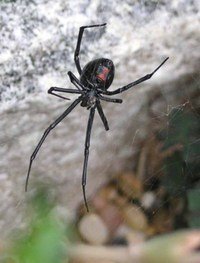
Now that I am an avid gardener, I have to not only co-exist with these little monsters, but actually work with them in the garden right along side me. I have finally begun to relax a bit around them. I really have no choice as there are hundreds in my little postage-stamp of a garden in southern California, seemingly in every dark corner in every planter box, under every rocky overhang and every abandoned pot and brick in the yard.
Black widows are a year-round companion in my garden. Grasshoppers, butterflies and other garden insect pests seem to come and go, Praying mantids hang about only when it's warm, orb weavers catch me in their large beautiful but ill-placed webs all spring and summer... but Black Widows are there day after day, month after month and are probably the most consistent co-habitants I have in the garden.
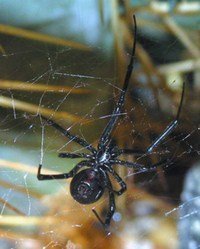
Black Widows (Latrodectus hesperus here in California) are in the family Theridiidae are indeed very toxic spiders (the venom is 15 times more potent than that of rattlesnake[1]), but bites from them reportedly have only a 1% mortality rate with most healthy adults getting over a bite in less than a week. Children and elderly individuals are at more of a risk for serious consequences from these spider bites, but actual deaths from Black Widow envenomation are still fairly rare. They are a non-aggressive species and shy away quickly if their webs are disturbed (sufficiently to make them realize it's not prey stuck in them--I have had a few spiders rush out to see what yummy thing they caught only to quickly realize it was me and then disappeared immediately). About the only way people get bit are if they pick up a spider or get one stuck in their clothing.
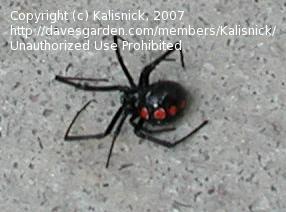
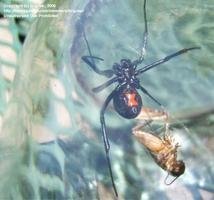
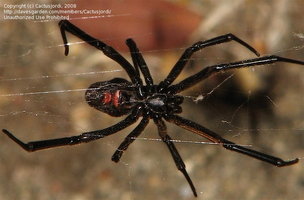
Northern Black Widow Latrodectus variolus (photo by kalisnick); middle photo is of Southern Black Widow Latrodectus mactus (photo by brignac); right photo is of Western Black Widow Latrodectus hesperus (photo by CactusJordi)
I recall an entomology field trip in college: we were all out in the brush--not far from campus in Northern California--armed with our nets and bottles, when I felt something climb up above my socks. To my horror, I peered down and saw the shiny, skittering body of a fat black spider disappear up my pants leg. All I remember next was jumping around like a lunatic and slapping my legs in a cold sweat for several minutes waiting for the inevitable bite I had heard was so painful. Fortunately these spiders are incredibly soft-bodied and it doesn't take much effort to squish one. Proudly taking my freshly squashed specimen to the instructor I was disappointedly reminded these were arachnids, not insects, and that I couldn't include such a mangled specimen in my collection anyway. All that near-death experience for nothing...
I have a number of pets and I am sure they have run across these spiders on occasion. But spider jaws are tiny and pets are furry, so the chances of a pet actually getting bitten by a Black Widow are fairly small. It does happen, however, and there is an available antivenin for such bites. As a veterinarian I have yet to diagnose a Black Widow bite in a pet in over 22 years of practice. Perhaps a missed a few, but no animals I have cared for have ever died from one that I know of.

our little Chihuahua, Scouty, being only a few pounds, could be at risk if bitten... however the risk of this actually happening is very slight
The spiders we recognize as Black Widows are the female spiders. Males are half the size, or smaller, lighter colored, have no red hourglass pattern, are skinny, and, like juvenile Widows, totally harmless. I am sure I must have seen a male Widow, but I can't recall such an experience. Widow webs are some of the least impressive-looking of all the spider webs I see in my yard. Obviously these spiders did not inherit any artistic ability like the orb weavers. Even most other garden spiders at least can create creepy looking webbed tunnels that run into their hiding places. Widow webs are randomly strewn, but tough, small structures usually spread across a structural corner, or between a group of fairly closely spaced plants (I have yet to see a web spanning any more than eighteen inches in my yard). They like to make webs in dark places, too, but there are plenty of their webs in more plain view in my garden. Females produce white, spherical egg sacs--between four to eight per life--and each sac can contain up to 400 eggs. Females only live about eight to fourteen months, and the males less than that. But with the possibility of cranking out more than 3000 babies over this short lifespan it is not surprising my yard does not run out of Black Widows. Actually, from what I've read, only 1% of the eggs will survive as little spiders even up to their first molt thanks to cannibalism, predation, lack of space to hide from the elements, lack of food, etc. Female spiders are nocturnal and the best time for me to see them is at dusk or dawn. I certainly see more in the summers than the winter, but they are visible all year round.
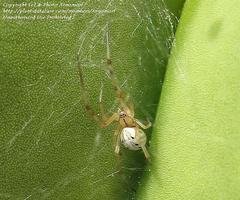 immature Black Widow (photo by Xenomorf)
immature Black Widow (photo by Xenomorf)
Black Widows get their name not just from being black but also their unsavory reputation for eating their mates after mating. This does not always happen and I have never witnessed this event. I see praying mantis in my yard do this frequently, however, and it seems so unfair. Glad I'm not a spider, or a mantis.
Though maligned as dangerous garden pests, Black Widows are efficient predators, and can be useful and valuable pest controllers. They obviously find enough to eat in my yard, or else there wouldn't be so many fat and healthy looking spiders all over the place. However, the major pests in my garden include giant grasshoppers, aloe mite, mealy bugs, scale, slugs and snails, none of which appear to be on the Black Widow's menu. They seem to prefer moths, flies and other flying insects. So how much real benefit they are to my yard I cannot really say. But they are here to stay so I have been trying to learn to live with them as best I can.
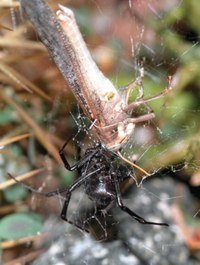
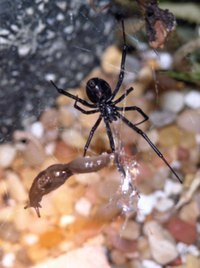
Rare 'catches' in my yard: a grasshopper and a slug (the slug eventually dropped out of the web- she completely ignored it)
[1] National Geographic
Copyright © www.100flowers.win Botanic Garden All Rights Reserved